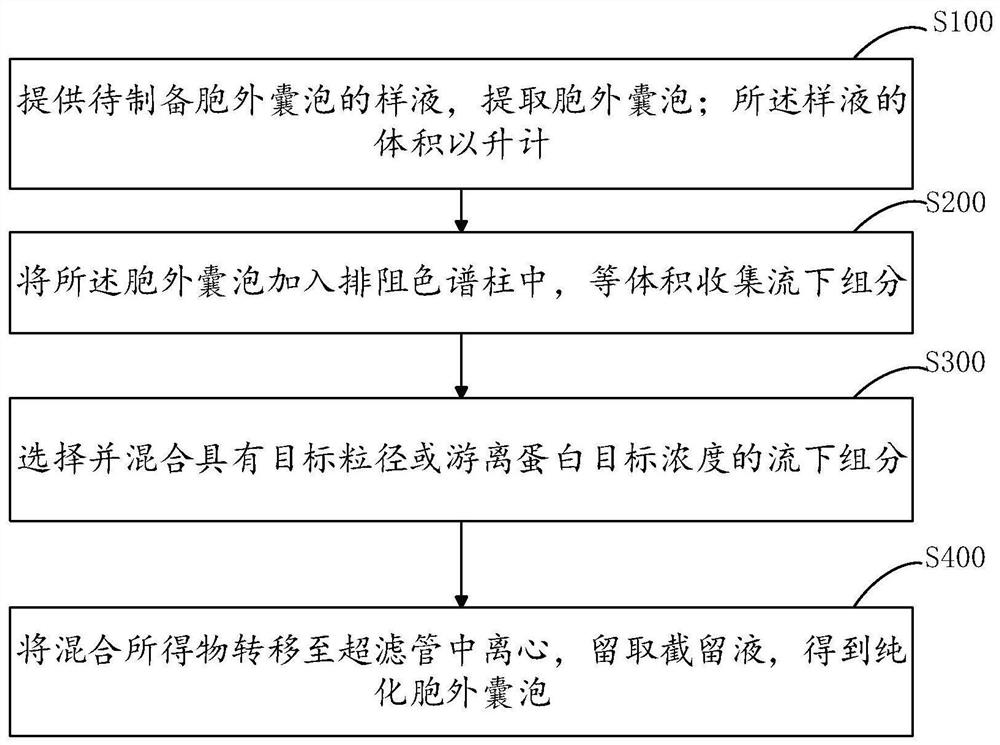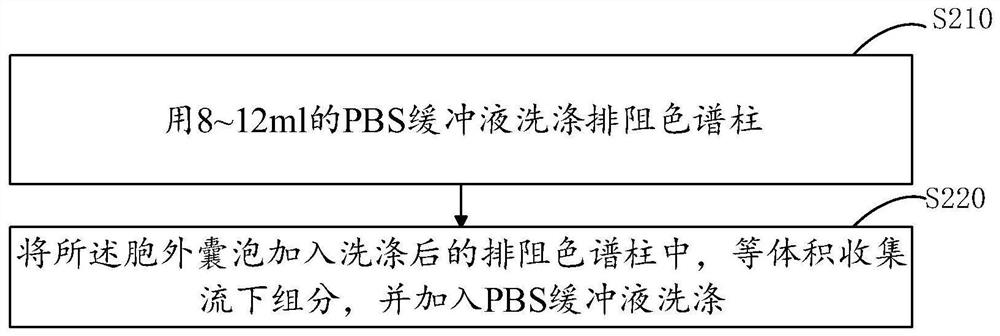Method for purifying extracellular vesicles
A purification method and vesicle technology, which can be used in plant cells, isolate microorganisms, etc., and can solve problems such as protein contamination, unsatisfactory, cumbersome operations, etc.
- Summary
- Abstract
- Description
- Claims
- Application Information
AI Technical Summary
Problems solved by technology
Method used
Image
Examples
Embodiment 1
[0076] The preparation of embodiment 1SEC column (size-exclusion chromatography column)
[0077] Wash Sepharose CL-2B (Sepharose) (Sepharose CL-2B Sepharose CL-2B, product number S8731-100mL) 3-4 times; 10mL disposable syringe, remove the needle, place a 20μm filter membrane (Mollipore ), placed vertically on the shelf. Slowly add the washed CL-2B into the syringe to ensure that the filtered liquid below is clear and transparent. Finally wash with 10mL PBS. SEC columns can be stored in a refrigerator at 4°C for 1 week.
Embodiment 2
[0078] Example 2 Purification of extracellular vesicles extracted by ultracentrifugation
[0079] A1, Escherichia coli E.Coil E4742 were cultured in 5L LB medium at 37°C and 150rpm / min until late exponential phase (OD600=1.2);
[0080] A2. Centrifuge the bacterial solution obtained in A1, centrifugation conditions: 4°C, 10000g, 15mins, to obtain the supernatant;
[0081] A3, the supernatant obtained in A2 is subjected to the first filtration treatment with a 0.45 μm filter membrane, and the filtrate is collected;
[0082] A4, the filtrate obtained in A3 is subjected to a second filtration treatment with a 0.22 μm filter membrane, and the filtrate is collected;
[0083] A5. Concentrate the filtrate obtained in A4 with a small tangential flow device (100kDa cutoff, Amicon, Merck) to finally obtain a 78mL concentrate;
[0084] A6. Pass the concentrated solution obtained in A5 through a 0.22 μm syringe filter (Merck Millipore, Ireland) for the third filtration treatment, and col...
Embodiment 3
[0096] Example 3 Purification of extracellular vesicles extracted by the kit (Bacterial Membrane Vesicle Isolation Kit (Bacterial Medium) 10ml, Runji Biology, Catnumber: BacMV10-10)
[0097] B1, Escherichia coli E.Coil E4742 were cultured in 1L LB medium at 37°C and 150rpm / min until late exponential phase (OD600=1.2);
[0098] B2. Centrifuge the bacterial liquid obtained in B1, centrifugation conditions: 4°C, 10000g, 15mins, to obtain the supernatant;
[0099] B3. The supernatant obtained in B2 is subjected to the first filtration treatment with a 0.45 μm filter membrane, and the filtrate is collected;
[0100] B4, the filtrate obtained in B3 is subjected to a second filtration treatment with a 0.22 μm filter membrane, and the filtrate is collected;
[0101] B5. Concentrate the filtrate obtained in B4 with a 100KD ultrafiltration tube (Merck Millipore, Ireland), centrifuge at 3000g at 4°C for 5-10mins, and finally obtain 20mL of the concentrate;
[0102] B6. Divide the conce...
PUM
| Property | Measurement | Unit |
|---|---|---|
| particle diameter | aaaaa | aaaaa |
Abstract
Description
Claims
Application Information
 Login to View More
Login to View More - R&D
- Intellectual Property
- Life Sciences
- Materials
- Tech Scout
- Unparalleled Data Quality
- Higher Quality Content
- 60% Fewer Hallucinations
Browse by: Latest US Patents, China's latest patents, Technical Efficacy Thesaurus, Application Domain, Technology Topic, Popular Technical Reports.
© 2025 PatSnap. All rights reserved.Legal|Privacy policy|Modern Slavery Act Transparency Statement|Sitemap|About US| Contact US: help@patsnap.com



